
Engineers from NASA and the Massachusetts Institute of Technology tested an aircraft wing designed to change in shape depending on control needs, MIT News reported Sunday. The test occurred in a NASA-owned wind tunnel.
Participating researchers said the wing holds potential to boost the efficiency of an aircraft’s production, maintenance and flight. The wing consists of multiple identical pieces that join together to form shapes.
Benjamin Jenett, a graduate student from the MIT Center for Bits and Atoms, said the wing’s variability accommodates the different phases of flight including takeoff, cruising, maneuvering and landing. The wing changes in form to match the aerodynamic requirements of each phase.
“We’re able to gain efficiency by matching the shape to the loads at different angles of attack,†said Nicholas Cramer a research engineer at NASA Ames Research California.





